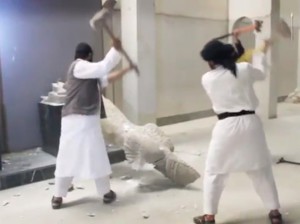
It was repugnant to watch the destruction of statues and archaeological relics by fanatics of the insurgent group ISIS (The Islamic State of Iraq and the Levant); as impressive as listening to the media reports lacking as usual, a proper context. Amnesiacs all.
I have not felt such repugnance since the 2001’s Taliban destruction of the Buddha statue at Bamiyan Valley, Afghanistan, nor when I accidentally saw that movie where the “archaeologist” Indiana Jones destroys much of the ancient Peruvian cultures.
Most of the destroyed objects in the museum of the city of Mosul, Iraq, came from northern Mesopotamia’s Assyrian culture, a paramount area for humanity; cradle of “civilization” where the first human settlements date from the Paleolithic and early Neolithic epochs. The area is located between the Tigris and Euphrates rivers in what is now Iran and Iraq.
But this anti-history assault is not the first. Iraq was bombed and invaded by the United States in 2003, a move that resulted in widespread looting and destruction of archaeological sites. Although very few media dared to report it, the ancient city of Babylon “paid an extremely high price after the U.S. used the site as military headquarters for five months.” The construction of a military base, according to John Curtis of the British Museum, is a product of “ignorance and stupidity.” Trenches 170 meters long and two meters deep “have caused irreversible damage”. (Global Policy Forum/Agence France-Presse. Dec. 8, 2008). Examples like this abound.
The grotesque acts of ISIS and the sketchy reports in the media reveal how close we are from the past, and how far from memory.
And I’m not talking about Hollywood nor the looting of Egyptian relics by the occupation troops of Napoleon Bonaparte at the end of 1700s (now proudly displayed in the Louvre). I’m talking about deliberate “official” plans of governments, of kingdoms to delete cultures that are not theirs.
One of the most ominous examples of these culture annihilations – very conveniently forgotten by the media, was the Spanish conquest and the introduction of Christianity in the Americas. Along the genocide there was a premeditated attack — through the destruction of temples and codices — to obliterate indigenous cultural heritage from the face of the earth.
“Spain’s unbridled intentions to expand its cultural reasoning included the devastation and repression of indigenous documental culture,” wrote the Mexican bibliographer Felipe Meneses Tello (August 2008).
The ancient indigenous heritage “is then lost forever. There was burnings of picto-hieroglyphic books, destruction of temples, statues of gods, and other monuments. Following the conquest it was risky to talk about books and monuments with inscriptions and statues of gods. To mention and possess them meant to appear as idolatrous and attract punishment and destruction of these testimonials remains.” (Miguel Leon-Portilla. Mexican historian. 1992). As grotesque war trophies, churches and cathedrals were built on top of temples and monuments of all the continent’s primary cultures.
The conqueror kills, religion deletes.
Lucien X. Polastron in his book “Books on Fire: history of the endless destruction of libraries,” does not talk about book-burning during the military coup backed by the U.S. in 1973 (Chile’s own 9/11), but narrates in details how Mexico’s Bishop Juan de Zumarraga completed the unfinished work of Hernán Cortés and in 1529 moved the library of the ‘enlightened capital of Anahuac and the large reservoir of the national archives’ to the market square of Tlatelolco and set them on fire. “The Bishop fulfills its mission satisfying his conscious desire to destroy the memory and pride of the natives” (Polastron. 2007).
The deliberated destruction of history is undoubtedly a human tragedy. But the intentional or unintentional omission; lack of context (media’s great disease), indifference to history, are equally objectionable.
Media outlets are like a conveyor belt for the geopolitical interests of Washington. If the Pentagon says that is the devil; that is the devil, if those states are the enemy; those are the enemy, if the Pentagon consigns to oblivion the fact that allied governments and cultures have also committed such war against culture… we will all fail to remember then.






